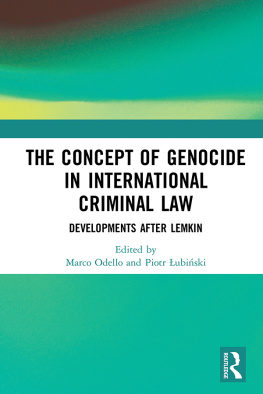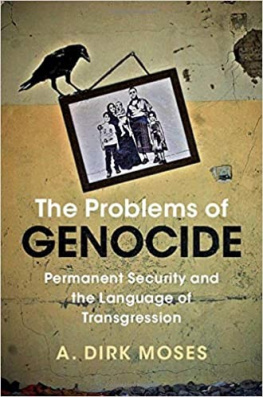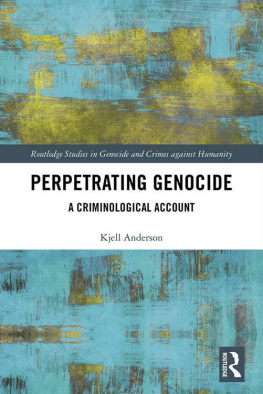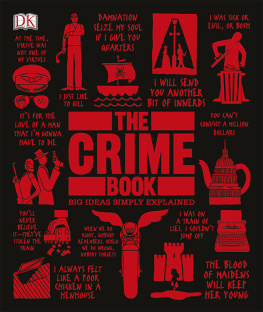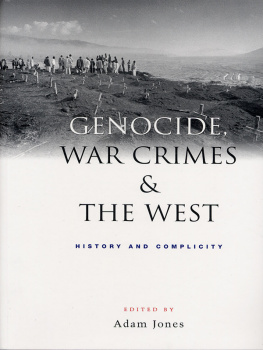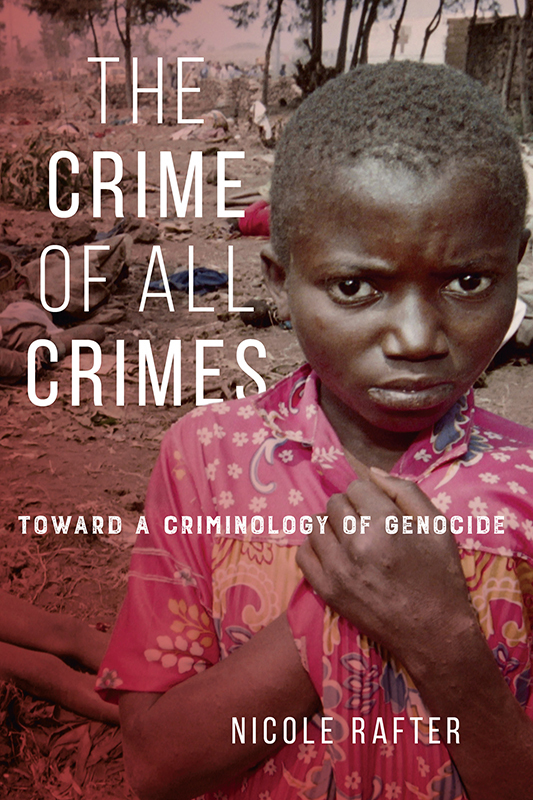
The Crime of All Crimes
The Crime of All Crimes
Toward a Criminology of Genocide
Nicole Rafter

NEW YORK UNIVERSITY PRESS
New York and London
NEW YORK UNIVERSITY PRESS
New York and London
www.nyupress.org
2016 by New York University
All rights reserved
References to Internet websites (URLs) were accurate at the time of writing. Neither the author nor New York University Press is responsible for URLs that may have expired or changed since the manuscript was prepared.
ISBN : 978-1-4798-5948-1
For Library of Congress Cataloging-in-Publication data, please contact the Library of Congress.
New York University Press books are printed on acid-free paper, and their binding materials are chosen for strength and durability. We strive to use environmentally responsible suppliers and materials to the greatest extent possible in publishing our books.
Manufactured in the United States of America
10 9 8 7 6 5 4 3 2 1
Also available as an ebook
For my beloved friend Susan Erony, who has spent much of her life painting images of genocide,
and in memory of another dear friend, Christine Margaret Alder, of Melbourne, Australia, 19502015
Contents
Figure 1.1. Twentieth-century genocides by location and frequency
Figure 1.2. Mass Grave at Katyn, Russia, 1943
Figure 1.3. Locations of genocides discussed in depth in this book
Figure 2.1. Relationship of the three atrocity crimes
Figure 3.1. Military portrait of Lothar von Trotha
Figure 3.2. Germans hanging 312 Herero in Southwest Africa, probably 1904
Figure 3.3. Captured Herero in chains
Figure 4.1. The Pancasila Monument
Figure 4.2. Seductive women on the Pancasila Monument
Figure 4.3. More of the Suharto narrative on the Pancasila Monument
Figure 5.1. Prisons and mass graves in Cambodia, 19751979
Figure 5.2. Tuol Sleng prison
Figure 6.1. Ethnic cleansing during the Armenian genocide
Figure 6.2. Body of an Armenian woman
Figure 6.3. Handicapped Jewish prisoners
Figure 6.4. Document authorizing Katyn Massacre
Figure 7.1. Schoolteacher killed during Rwandan genocide
Figure 7.2. Jean-Paul Akayesu
Figure 8.1. Guatemala dead, 1982
Figure 8.2. Exhumation in the Ixil Triangle, Guatemala
This book was born in a specific time and placeand as quite a surprise to me. I had gone to Linz, Austria, on a Fulbright Fellowship to teach at Johannes Kepler University. I soon discovered that Linz was Adolf Hitlers hometown. He was born nearby; he went to grade school in a gloomy, abandoned building a few blocks behind my apartment; and his mothers house was still standing on the other side of the Danube. I walked to it across the grandiose Nibelungen Bridge, named and designed by Hitler as the entrance to what he intended to be his mausoleum. From my fifth-floor window above the Hauptplatz, I looked down on the balcony from which Hitler announced Germanys annexation of Austriaan occasion for wild celebration by most of Linzs inhabitantsthough not, of course, for its Jews, most of whom were dead within the week or deported to Dachau.
A few years before I moved to Linz, the European Union had chosen the city as a cultural capital, giving it prize money to encourage cultural development and tourism. Some of the funds went to an artists project that identified locations of events from the Nazi period and then stenciled, in white paint, brief descriptions on the pavement:
April 1945; 8 Marienstrasse. Anton A. is departmental head of the city administration and criticizes the execution of two female Eastern workers for the theft of milk as being inhuman. He is sentenced to death and shot.
1943. 20 Lederergasse. The teacher Hermine L. writes a number of letters that were critical of the regime to her brother Walter who is a soldier stationed in Vienna. Both were sentenced to death and executed.
Everywhere I turned, I was brought up short by reminders of the Third Reich. I passed Adolf Eichmanns apartment on my way to the market. A few kilometers down the Danube was Hartheim Castle, where mentally disabled inhabitants of the region, considered threats to the purity of Aryan blood, were euthanized in one of the first gas chambers. In the other direction lay the Mauthausen concentration camp, for extermination through labor. Reaching out from Mauthausen like tentacles were the cold, dank tunnels of the Gusen and Ebensee underground camps, where skeletal prisoners produced munitions, airplanes, and V-2 rockets until they died and were tossed on the heaps of corpses in the corridors.
I had gone to Linz planning to write a history of criminology and ended up beginning a book on genocide. Although I had no ambition to add to the history of Linz or the Nazi system, I was transfixed by Hartheim Castle, associated as it was with the mentally disabled, a population whose criminalization I had been writing about for decades. For years after I returned to the United States, I corresponded with Cathrin Dorner, the docent who had given me my tour of Hartheim, questioning her about the layout of the institution, its history, and her experience of working so close to a gas chamber. Eventually I chose the Nazis efforts to exterminate the mentally disabled for in-depth treatment in this book. I was nearly finished with the books final chapter when I discovered that the great-grandfather of one of my Austrian students had died in the Hartheim gas chamber.
* * *
Raphael Lemkin, the Polish specialist in international law who coined the word genocide, founded modern genocide research before and during World War II by studying the Armenian and Ukrainian genocides and the rules imposed by the Nazis on occupied countries. After World War II, Lemkin continued research on genocide; after his death in 1959, this work was continued by historians and sociologists such as Leo Kuper, Helen Fein, and Raul Hilberg. Many early students of genocide were Jews; some had been born in Europe and lived through the Holocaust. Holocaust studies slowly expanded, remaining a field in its own right while also branching off into genocide studies. Stimulated by the atrocities in Rwanda and the former Yugoslavia, genocide studies exploded in the 1990s, spreading to new fields and drawing in researchers with no direct connection to the Holocaust. This book is part of that expansion.
One of my biggest problems in writing this book was simply keeping abreast of the flood of journal articles, monographs, edited collections, and government reports on genocide. I asked Google Scholar to keep me updated on all publications concerned with genocide, which resulted in an almost daily list. (I grew to dread opening it, for each new source that I added to my working bibliography slowed my writing process.) Genocide studies today is truly a crowded, multidisciplinary fieldbut it has seldom dealt with genocide as a crime. A few criminologists have already written about genocide; with them, I aim at adding criminology to the interdisciplinary mix.
* * *
I could not have produced this book without the help of numerous friends and colleagues. Graduate students gave generously of their insights and time, especially members of my Crimes against Humanity seminars. Laura Siller, mobilizing undergraduate Jocelyn Griffin to assist her, organized my data using the NVIVO programand lit up my office with the sparks of her ideas. Jeff Botto, another graduate student, prepared appendix A and my graph of twentieth-century genocides. My doctoral student Kristin Bell-Gerke, with whom I coauthored an essay on gender and genocide, read and commented astutely on the entire manuscriptparts of it several times. I was helped greatly by Katharina Neissl, whom I first met as a student in Linz and whom I lured to Northeastern Universitys graduate program. The books Katharina and her family have given me greatly expanded my library on Linz and National Socialism in Austria. My former graduate student Chad Posick, now at Georgia Southern University, also commented on the entire book and discussed new ideas with me. Andrew Baranauskas, a current Northeastern gradute student, helped me prepare the Index.
Next page

